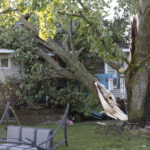Travis County District Court jury to the insurance industry: take care of toxic mold claims adequately and promptly or risk being assessed millions of dollars.
That warning came in the form of a $32-million award to a Dripping Springs family after the jury concluded that a subsidiary of Farmers Insurance Group mishandled the family’s claim. The Austin American-Statesman noted that the June 1 award is one of the first in the nation to order an insurance company to pay damages to the homeowner in a toxic mold case.
In their lawsuit against Farmers’ subsidiary, Fire Insurance Exchange (FIE), homeowners Melinda Ballard and Ron Allison alleged the company mishandled their claim. They requested $100 million in restitution. According to Ballard and Allison, Farmers delayed in covering repairs for a water leak in the couple’s 22-room mansion and ignored contractors’ warnings that dangerous molds could grow under the house’s sub-flooring if the sub-flooring were not pulled up. The couple said Farmers’ failure to properly handle the claim allowed the toxic mold Stachybotrys atra to take over their house, which damaged the family’s health.
Judge John Dietz previously ruled that medical testimony on health effects of mold could not be introduced because the level of scientific proof required by a Texas Supreme Court mandate does not yet exist; however, the jury found that the house was damaged beyond repair and that it will have to be demolished and rebuilt. The Statesman reported that the family was awarded $6.2 million in actual damages, $12 million in punitive damages, $5 million for mental anguish and $8.9 million for lawyer’s fees.
According to court documents in Ballard v. Fire Insurance Exchange (Travis Co. Cause No. 99-05252), Ballard experienced a plumbing leak in a bathroom in 1998, had it repaired, and that several months later the house’s hardwood floors started buckling. Ballard filed a claim with Farmers, which had insured her home since 1992. The suit alleges that in December 1998, a flooring contractor cautioned Farmers about the potential for dangerous mold growth but Farmers ignored the contractor’s warning. Instead, the company reportedly followed the advice of a Farmers adjuster who indicated that the problem was related to the settling of the slab and was not covered by Ballard’s policy. In addition, the Farmers was alleged to have conducted a plumbing check but reported that it had found no leaks.
In early 1999, the family—Ballard, Allison and their three-year-old son, Reese—experienced the first of a number of unexplained illnesses, including coughing up blood. The condition of the floors got worse, and walls, windows and doors were damaged as a result of the subfloor being waterlogged. Farmers tried to settle the claim at that time, but offered an amount that the homeowners considered insufficient to cover the damages to the home.
According to the complaint, a Houston microbiologist retained by Farmers, Dan Bridge of Rimkus Engineering, found that the space contained airborne Stachbotrys spores. However, neither Farmers nor Bridge informed the family about the discovery until after the illnesses occurred. Ballard and Allison hired scientists from Texas Tech University to test the home, and after the presence of toxic mold spores was confirmed, the family moved out.
Commenting on the case, Austin attorney Sean Michael Quinn, who specializes in insurance matters, said it is unlikely that the $32 million assessment will stand after the case moves through the appellate courts, as it is expected to do. However, the impact of the jury’s award in an “ably tried case on both sides” will reverberate through the insurance industry, Quinn said. He noted that in fact, the case has already influenced the way that insurance companies handle mold claims, even before the jury award, causing them to be more careful in the handling of those claims.
Quinn speculated that one result of the jury award will be to make insurance companies stand up and take notice that “maybe ‘bad faith’ is not dead in Texas.” He said the award sends a message that “here’s what a jury will do” in a case like this and that insurance companies are likely to gear up with a faster, more adequate response. Another result of the award could be that surplus lines carriers, which are not required to have state approval of their forms, will begin to issue specific exclusions for mold, Quinn said.
Appeal
Chris Martin, an attorney with Martin, Disiere & Jefferson, a Houston-based firm that specializes in insurance law, agreed that Farmers will probably appeal the verdict. He said that the trial will not conclude until Judge Dietz hands down his judgement on the verdict, noting that attorneys on both sides are preparing motions for such a judgment. Farmers’ motions will likely request, among other things, a reduction in the damages and, perhaps more importantly, that the judge find the plaintiffs’ claims for damages were not covered under the homeowners’ policy. Martin said that the coverage question is a huge one for the industry and added that even if the judge reduces the damages, Farmers is sure to appeal.
Mold/Illness Relationship
As noted by the trial judge, the relationship between airborne toxic mold spores and adverse health effects is so far unclear and unproven. While it has been reported that Stachybotrys atra and certain other toxic molds produce micotoxins can cause unique or rare health conditions such as pulmonary hemorrhage or memory loss, the Centers for Disease Control and Prevention (CDC) report that there is a lack of significant data that scientifically links toxic mold to these conditions.
According to the CDC, common health concerns from molds include hay-fever like allergy symptoms. And certain individuals with chronic respiratory disease (chronic obstructive pulmonary disorder, asthma) may experience difficulty breathing in the presence of molds. CDC information suggests that molds are very common in buildings and homes and will grow anywhere indoors where there is moisture. The most common indoor molds are Cladosporium, Penicillium, Aspergillus, and Alternaria. Accurate information about how often Stachybotrys chartarum (or Stachybotrys atra) is found in buildings and homes is not available. According to the CDC, although Stachybotrys atra is less common than other mold species it is not rare.
Quade R. Stahl, Ph. D., director of the Indoor Air Quality division at the Texas Department of Health concurs that, while much anecdotal evidence suggests a link between the toxic molds and health problems, more data is needed to prove a positive connection. Stahl said that the collection of sufficient data will be a “slow and tedious process that is not going to happen next year.” He added that since media coverage of mold cases has increased, the number of mold-related calls to TDH has increased significantly. A Texas Department of Insurance (TDI) spokesman indicated that the agency has also seen an increase in mold complaints in recent months. He said that while TDI has only had about 16 complaints about the quality of service provided by insurance companies in mold cases in the past 10 years, nine of those have occurred in the past six months.
Dallas attorney Beth Bradley, who has represented insurance companies in a number of mold cases and has followed the developments in the Ballard case closely, agreed that there is “not a lot of hard evidence connecting mold” to illnesses. She said that media coverage of the Ballard case is likely to feed the hysteria surrounding mold issues, but added, “we are just now starting to see the other side of the story” in these cases. Bradley said that concerns about unscrupulous remediation contractors have begun to surface, adding that inflated repairs are likely to drive insurance costs up. In addition, false positives for Stachybotrys caused by improper testing are common and are also a cause for concern, Bradley said.
Hysteria or Reality? Either Way, Costs Add Up
The Ballard case has received intense media scrutiny, and while significant, it is not the only mold-related case moving through the court system in Texas or the U.S. In May, the Delaware Supreme Court upheld a $1 million verdict in a mold exposure case and found that a landlord can be held liable for injuries suffered by its tenants because of mycotoxins, bacteria and fungi within an apartment. The plaintiffs in that case claimed that exposure to toxic mold spores while living in an apartment complex prevented them from performing their regular duties, and caused economic losses and illnesses such as asthma, permanent cognitive defects, osteopenia and an increased risk of tuberculosis that will require future medical care.
Various school districts in Texas have been hit with lawsuits involving toxic mold claims. The Edinburg School District and the Pharr/San Juan/Alamo School District are facing claims concerning bad air quality and illnesses allegedly cause by mold contamination. In Pharr/San Juan/Alamo, the school district is both a plaintiff and a defendant. The district is suing the contractor for construction defects in the heating-ventilation-air conditioning (HVAC) systems in a new school, while students, parents and teachers at the school have joined in a consolidated suit against the district over health damages.
In the Austin area, a number of schools have been diagnosed with mold problems. Millions were spent on the cleanup of Hill Elementary School, which was shut down for over a year after Stachbotrys and another mold were found in the school in March 2000. Eight other Austin schools will undergo an extensive process of fixing mold problems that the district expects will come with a more than $10 million price tag.
Mold issues are “the hottest things going in Texas insurance right now,” Martin said, “and the media are contributing to the hysteria.” He said that the majority of the claims that companies are seeing are not ones where the claimants actually see mold. Often, they begin to experience allergy symptoms and ask the
insurance companies to investigate. A large number of claims are generated by lawyers, neighbors or friends who may suggest that a claimant may have mold problems, Martin said. Finally, a smaller number of the claims are “legitimate water damage claims where mold and fungus grow due to water damage,” he said.
TDI Hearing on Mold Coverage
The Texas Department of Insurance is scheduled to hear testimony at a June 26 public hearing from interested parties on the mold and fungi coverage currently provided in Texas homeowner’s policies.
In Texas, standard homeowners and dwelling policies HO-B, HO-C, HO-CT,HO-CON, AND TDP-3 contain exclusions for losses caused by rot, mold and other fungi. But coverage is provided in these policies and in forms HO-BT, HO-CON-B, AND TDP-2 when mold or fungi growth is the result of a covered loss, such as water damage.
Additionally, proposals by Farmers and other insurance companies to completely eliminate mold damage coverage in residential policies will be addressed. Insurers, consumers, and mortgage lenders are among those expected to comment at the hearing, which will begin at 9:30 a.m. in Austin. Parties wishing to testify must complete a witness registration card, either before or during the hearing.
| 10 Things You Should Know About Mold | |||||||||||
|
Source: The CDC’s National Center for Environmental Health (NCEH). |
||||||||||
Topics Carriers Texas Claims Agribusiness Homeowners Market Contractors Education
Was this article valuable?
Here are more articles you may enjoy.


 One of Highest Property Claims Severity Recorded in Q3 on Low Volume, Says Verisk
One of Highest Property Claims Severity Recorded in Q3 on Low Volume, Says Verisk  Hartford: 10-Year Analysis Shows Shifts in Common, Expensive Small-Business Claims
Hartford: 10-Year Analysis Shows Shifts in Common, Expensive Small-Business Claims  Pierce Named CEO of GEICO as Combs Resigns
Pierce Named CEO of GEICO as Combs Resigns  Baldwin Group to Buy CAC Group for About $1B in Cash and Stock
Baldwin Group to Buy CAC Group for About $1B in Cash and Stock 


